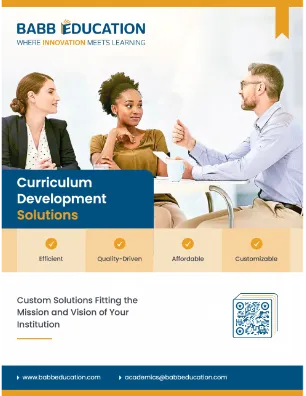Online courses are an essential component of modern education, offering flexibility and accessibility to learners worldwide.
Online courses are an essential component of modern education, offering flexibility and accessibility to learners worldwide. One of the significant challenges of virtual learning environments remains how to best create a sense of community designed to foster engagement and satisfaction for learners. Building a strong community in online courses is crucial for enhancing student engagement, promoting collaboration, and ensuring student success. In this blog post, you explore effective strategies for fostering collaboration, peer support, and social presence in virtual learning environments.
The Importance of Community in Online Learning
Creating a sense of community in online courses is not just a "nice-to-have" aspect but a critical element for student success. Typically, students who feel connected to their peers and instructors are more likely to engage in course activities, persist through challenges, and achieve better learning outcomes. Additionally, a strong sense of community can increase student motivation, deepen learning, and lead to higher satisfaction and retention rates.
Benefits of a Strong Online Community
There are several benefits of creating a strong online community within eLearning. For example:
- Enhanced Engagement: Students are more likely to participate in discussions and activities when they feel connected to their peers.
- Increased Satisfaction: A supportive community can lead to higher levels of student satisfaction, reducing dropout rates.
- Improved Learning Outcomes: Collaborative learning environments encourage critical thinking and deeper understanding of the material.
- Peer Support: A community provides a network for students to share resources, offer support, and solve problems together.
Strategies for Building Community in Online Courses
Building a strong sense of community in an online course requires intentional design and facilitation. Below are some strategies to foster collaboration, peer support, and social presence:
Design Engaging and Interactive Content
Interactive content is key to engaging students and encouraging participation. Consider the following techniques to make your course content more engaging:
- Discussion Forums: Facilitate discussions that encourage students to share their thoughts and experiences. Use open-ended questions to prompt critical thinking and dialogue.
- Collaborative Projects: Assign group projects requiring students to work together, share ideas, and produce a collective outcome. This not only builds community but also enhances learning through peer interaction.
- Peer Reviews: Incorporate peer review activities where students can give and receive feedback; this process encourages reflection and helps students learn from each other.
Create Opportunities for Social Interaction
Social interaction is essential for building relationships and fostering a sense of belonging. Here are some ways to promote social presence in your online course:
- Virtual Icebreakers: Begin the course with icebreaker activities that allow students to introduce themselves and get to know their peers.
- Social Media Integration: Use platforms like Facebook, Twitter, or LinkedIn to create informal spaces where students can connect, share resources, and discuss topics related to the course.
- Live Sessions: Schedule regular live sessions for office hours; using video conferencing tools like Zoom or Microsoft Teams. Live sessions provide opportunities for real-time interaction and help humanize the online learning experience.
Foster a Supportive Learning Environment
Creating a supportive learning environment involves establishing clear communication channels and providing consistent support. Consider these strategies:
- Communicate Clearly: Clearly communicate course expectations, timelines, and guidelines. Use announcements, emails, and course dashboards to keep students informed.
- Provide Feedback: Provide timely and constructive feedback on assignments and assessments. Encourage students to ask questions and seek clarification when needed.
- Share Access: Provide students with access to resources. For example, study guides, tutorials, and additional reading materials and videos. Ensure students know how to access technical support, if needed.
Encourage Instructor Presence
Instructor presence is crucial for guiding the learning experience and building community. Here’s how instructors can maintain an active presence:
- Communicate Often: Send regular updates and check-ins to keep students engaged and informed about their course progress.
- Active Participation: Participate in discussion forums and respond to student queries promptly. Show genuine interest in students' contributions and offer encouragement.
- Personalize Communication: Personalize your communication by addressing students by name and referencing their contributions; this helps build rapport and can make students feel valued.
Measuring Success and Continuous Improvement
Building a sense of community in online courses is an ongoing process requiring continuous evaluation and improvement. Here are some ways to both measure success and refine your strategies:
- Collect Feedback: Regularly collect feedback from students about their experience in the course. Use surveys and questionnaires to gather insights into what is working well and what could be improved.
- Use Metrics: Monitor engagement metrics such as discussion forum participation, assignment completion rates, and attendance in live sessions. These metrics can provide valuable insights into student engagement levels.
- Reflect and Adapt: Reflect on the feedback and data collected and make necessary adjustments to the course design and facilitation strategies. Be open to trying new approaches and continuously improving the learning experience for you and your learners!
Prioritizing community-building in online courses is essential for fostering meaningful learning experiences and achieving positive outcomes for learners. By creating a strong sense of community, educators can enhance student engagement, motivation, and satisfaction, leading to reduced dropout rates.
How Babb Education Can Help
Babb Education understands that working with faculty to prioritize community-building in online courses is essential for fostering meaningful learning experiences and achieving positive outcomes for learners. As such, we are dedicated to supporting educators and institutions in creating vibrant online learning communities. Our team of experts offers a range of services to help you build and sustain a strong community in your online courses



